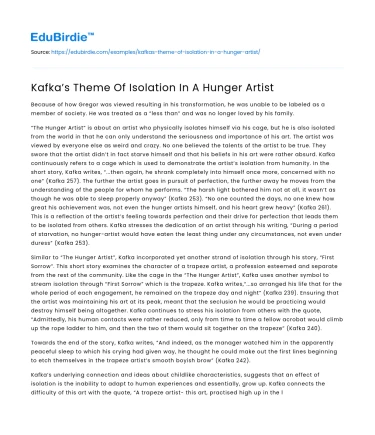Because of how Gregor was viewed resulting in his transformation, he was unable to be labeled as a member of society. He was treated as a “less than” and was no longer loved by his family.
“The Hunger Artist” is about an artist who physically isolates himself via his cage, but he is also isolated from the world in that he can only understand the seriousness and importance of his art. The artist was viewed by everyone else as weird and crazy. No one believed the talents of the artist to be true. They swore that the artist didn’t in fact starve himself and that his beliefs in his art were rather absurd. Kafka continuously refers to a cage which is used to demonstrate the artist’s isolation from humanity. In the short story, Kafka writes, “...then again, he shrank completely into himself once more, concerned with no one” (Kafka 257). The further the artist goes in pursuit of perfection, the further away he moves from the understanding of the people for whom he performs. “The harsh light bothered him not at all, it wasn’t as though he was able to sleep properly anyway” (Kafka 253). “No one counted the days, no one knew how great his achievement was, not even the hunger artists himself, and his heart grew heavy” (Kafka 261). This is a reflection of the artist’s feeling towards perfection and their drive for perfection that leads them to be isolated from others. Kafka stresses the dedication of an artist through his writing, “During a period of starvation, no hunger-artist would have eaten the least thing under any circumstances, not even under duress” (Kafka 253).
Save your time!
We can take care of your essay
- Proper editing and formatting
- Free revision, title page, and bibliography
- Flexible prices and money-back guarantee
Similar to “The Hunger Artist”, Kafka incorporated yet another strand of isolation through his story, “First Sorrow”. This short story examines the character of a trapeze artist, a profession esteemed and separate from the rest of the community. Like the cage in the “The Hunger Artist”, Kafka uses another symbol to stream isolation through “First Sorrow” which is the trapeze. Kafka writes,“...so arranged his life that for the whole period of each engagement, he remained on the trapeze day and night” (Kafka 239). Ensuring that the artist was maintaining his art at its peak, meant that the seclusion he would be practicing would destroy himself being altogether. Kafka continues to stress his isolation from others with the quote, “Admittedly, his human contacts were rather reduced, only from time to time a fellow acrobat would climb up the rope ladder to him, and then the two of them would sit together on the trapeze” (Kafka 240).
Towards the end of the story, Kafka writes, “And indeed, as the manager watched him in the apparently peaceful sleep to which his crying had given way, he thought he could make out the first lines beginning to etch themselves in the trapeze artist’s smooth boyish brow” (Kafka 242).
Kafka’s underlying connection and ideas about childlike characteristics, suggests that an effect of isolation is the inability to adapt to human experiences and essentially, grow up. Kafka connects the difficulty of this art with the quote, “A trapeze artist- this art, practised high up in the lofty domes of the great variety theatres, is known to be one of the most difficult to which humans may aspire- had, first out of the striving for perfection” (Kafka 239).
Kafka’s theme of isolation does not go unnoticed through his work. This theme is especially prominent in his stories, “Metamorphosis”, “The Hunger Artist”, and “First Sorrow”. Society is often blinded by the realms of the real world, its impositions cripple humanity and concludes to be the reason for seclusion (this sentence is awkward. What are you trying to say?). Kafka’s message seems to suggest that as humans we need society in order to truly belong and have a connection, purpose and worth inis this life. In order to truly live, we would need to open up the door, break through the cage, and come down from the trapeze.
Expand this conclusion. Make sure you answer the so what? question. Your conclusion should enhance the reader's understanding of what you established in your introduction. Consider how Kafka lacked true connections in his own life.






 Stuck on your essay?
Stuck on your essay?

